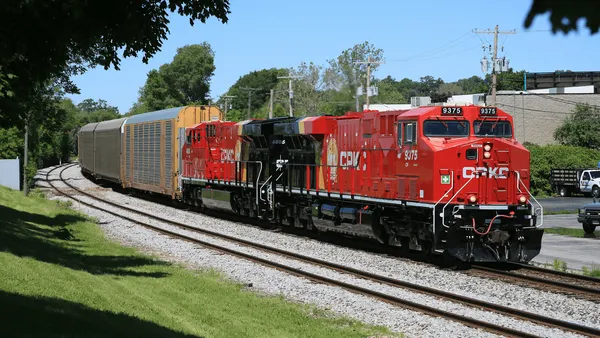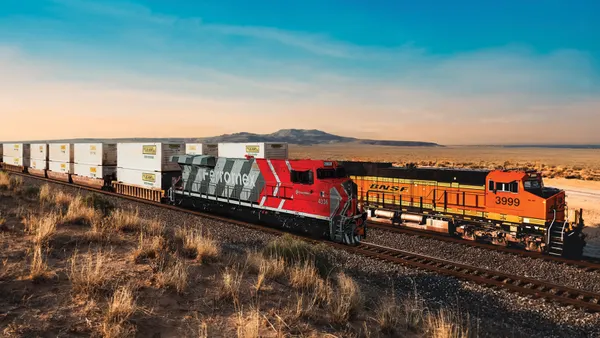Dive Brief:
- U.S. railroads originated 912,77 carloads in September, a nearly 7% YoY decline, and about 1.2 million intermodal containers, an increase of 10% YoY, according to the latest numbers from the Association of American Railroads.
- "Thanks largely to rising imports and inventory restocking in preparation for the holidays, October was the best month ever for U.S. rail intermodal, with volumes up by a third from April of this year. That’s a stunning increase in six months," AAR Senior Vice President John T. Gray said in a statement.
- Intermodal shipments continue to be strong into November, up 11% YoY in the 45th week of the year. But automotive, industrial and construction shipments were down YoY, according to a research note from UBS.
Dive Insight:
AAR called October the "best month ever" for intermodal, even though numbers show September 2020 having higher intermodal volumes. But an AAR spokesperson said the weekly averages explain why October is considered the biggest month for intermodal volume.
"September 2020 was a 5 week month and those total volumes were higher than October," the spokesperson said via email. "However, October’s weekly average was higher. Since there is the variance on the number of weeks in a month frequently, that is the way that our policy and economics team equalizes the data."
Railroads have been talking for years about the potential to attract shippers to the intermodal market. Now, a hectic freight environment that has led to a capacity crunch in the trucking market has resulted in railroads experiencing increased interest in their business.
"The 12% to 15% discount that rail offers, given with our good service product, has allowed us to go and sit down with our customers," and talk to them about moving more freight via train, Mark Wallace, the executive vice president of sales and marketing at CSX, told analysts on the company's earnings call at the end of October. "And they can't get trucks. The truck market is tight. The spot rates are up. And so we are seeing conversions there."
J.B. Hunt CEO John Roberts said the company is talking internally and with customers about expanding its intermodal fleet. XPO CEO Bradley Jacobs described the intermodal rebound as "massive."
At an analyst conference Tuesday, Union Pacific said its intermodal volume for Q4 to date is up 14% YoY. Restocking is "alive and well," and the continued need for it going forward will depend on consumer spending and retail sales, Union Pacific CFO Jennifer Hamann said during the Stephens Investment Conference.
"We've got a big furniture store here in town and one of the anecdotes that we've heard recently is that they normally have, call it 4,000 refrigerators in stock at any one point in time and more recently they've got like 400," Hamann said.
Union Pacific has responded with surcharges as intermodal volume has swelled.
"We still have surcharges in place and that really is to help protect some of the capacity," Hamann said at the Baird 2020 Global Industrial Conference last week. "We have programs with some of our domestic intermodal customers, where they commit to giving us so much volume over the course of the year, and we commit to giving them box availability. And that's really what the surcharges are about, is helping protect those customer commitments."
Moving forward, the railroads have their eyes on the trucking market to continue to chip away at its business.
"The trucking industry seems to be more plagued by challenges year-after-year-after-year-after-year than even the railroad industry does," CSX CEO Jim Foote said at the same Stephens conference. "We've changed our mindset, we've changed our focus, we've changed the way we want to do business."
Hamann said the conversations from the truckload market have remained fairly consistent, though she noted that Union Pacific's marketing team is targeting truckload shippers to highlight rail as a green alternative, adding that the railroad's improved service metrics in recent years help to make its case.
"I don't know if I would say we've seen an acceleration in the truckload wins," she said. "We're just going into that bid season right now and the fact that truck capacity has stayed tight and looks to be tight going into the first part of [2021] can be a favorable dynamic for us."
Foote noted that CSX will look to increase prices as its service improves, but he said the railroad is not following the trucking spot market for pricing guidance.
"That's really not the nature of the way we do business," Foote said of watching spot rates. "We have long-term relationships with customers. And so, price increases ... should continue to be consistent with what they've been over the last couple of years at CSX."













